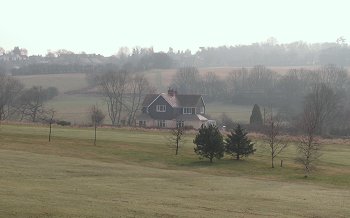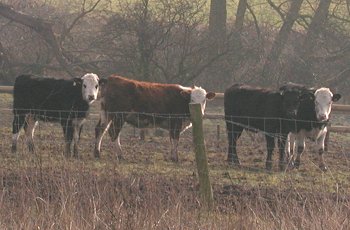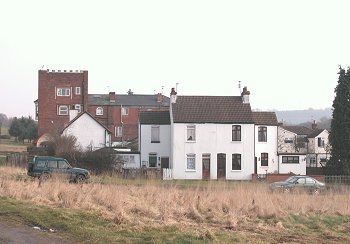|
The Animals
Our Pigs
There’s a lot to farming that people don’t know
about. My aunt used to buy the pigs when they were little and
rear them. When they were big enough we used to have the butcher
up from Wombourne to kill them for bacon and meat. They never
used to tell us when they were going to kill a pig. If we were
at home we would be sent to Gospel End, to do a pile of
shopping, which would take us ages because we used to play
about, swinging on trees and one thing and another. We were sent
out of the way so as not to hear the pigs squealing. You’ve only
got to look at a pig and it will squeal. They knew the butcher
from anyone else. By the time we got back the pigs were killed
and hung-up. The pigs were hung-up for about a day. We had a
back kitchen as we used to call it, where you went in through
two double doors and they used to hang the pigs there. They were
hung upside down by their two hind legs. I went rushing in from
school one night and landed with my arms around this pig hanging
up. |
|

Baggeridge Cottage. |
After about a day my cousin used to cut right down
the middle of the spine and take the legs off them. I had to fill
the boiler in the boiler house with spring water. My aunt would
light the boiler and the carcases would be scalded to remove the
hair. The butcher used to come from town and cut the carcases up for
bacon and ham and things like that. We kept the meat for us. Two
pigs would be killed at a time and one would be given to my cousin
who lived across the way. |
| A man would come from Gornal with a flat float
pulled by two horses and bring bricks of salt. The bricks were a
couple of feet wide and I used to help to cut them up with a
chopper. The salt had to be rubbed all over meat, inside and out and
then it was hung up again until it was ready to be used. Salted
bacon tasted so much better than bacon that hadn’t been salted. |
When you’ve got a farm you grow up with the idea of
animals being killed. You’ve got to do it; it’s a way of life.
I used to love the scratchings. It’s like a layer of fat all the
way down the middle of the back. It peeled off as clean as can be.
It was my job to cut it into squares and I had to sit there until it
had cooked and the lard had come out. The lard was strained off and
the fat was pressed and then dried out in the oven. The scratchings
were lovely. They tasted much better than the ones that you buy
today. |

Some of the cattle that can still be found
on the common. In the background is Nash's cottage. |
| Our Cows
I had an aunt who lived at Cleobury Mortimer, right out in the
wilds. Sometimes we would have a cow brought over from there on
a cart. The cows were milked in the cowsheds which had to be
cleaned every day. The milk inspector used to come around and
check. Even the ceiling had to be wiped. The walls were
regularly lime washed and the floors and feeding troughs were
scrubbed out twice a day. |
|

These cows are in one of the fields next to
Penn Brook. |
Len, my cousin, used to go to Chapel Ash, to Banks’s
Brewery and come back with two big churns full of the wheat that had
been used in making the beer. They used to mix it with their food
and they also had the grass in the fields. Len used to be coming
back from the brewery as we came out of school at about 12 o’clock
and he used to tell us to get on the back. We did and there was this
big pile of wheat. It was still steaming and hot. It used to smell
lovely. We used to pinch a bit sometimes to eat. He did that every
Monday for years. |
| We used to buy straw from Shrewsbury way, I think.
My cousin had a barn where he kept the straw and used to look after
taking the cows to market. He used to occasionally take some to
Bridgnorth market. He could get two on his float at a time.
Our Chickens
|
| My cousins used to take the milk out in churns and a
lot of people used to ask for a fowl, and we would get it ready for
the next morning. My brother used to kill the fowl, they were always
dressed, plucked and gutted, it was a lot of work. They were never
sent with their feathers on. Most of the fowl were killed while we
were at school and then I used to have to pluck them. I didn’t mind
doing that; we wouldn’t have any dinner if we didn’t do it. That was
a big job of mine on a Saturday, plucking fowl, I didn’t like
gutting them though. |

Alton Cottages behind the old brewery. |
| I used to have a black apron on that came down to
my feet and had the bird on my lap. It’s quite easy to do. My aunt
would do all the rest like the gutting.
The feathers were sterilised in the oven to kill any fleas or
anything else that was on them and made into cushions and
pillows. We didn’t throw any feathers away, only the big ones,
the wing feathers, they were no good. The feathers were put into
paper bags and placed in the oven to sterilise them. They made
nice soft pillows. |
|

|
|

|
|

|
| Return to
Brook Cottage |
|
Return to
the beginning |
|
Proceed to
The Woods |
|